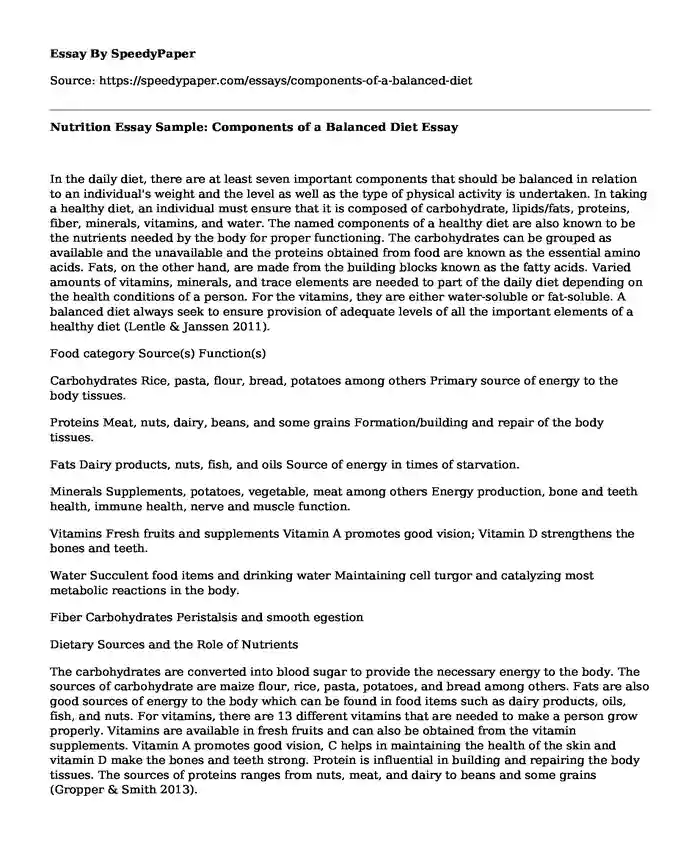In the daily diet, there are at least seven important components that should be balanced in relation to an individual's weight and the level as well as the type of physical activity is undertaken. In taking a healthy diet, an individual must ensure that it is composed of carbohydrate, lipids/fats, proteins, fiber, minerals, vitamins, and water. The named components of a healthy diet are also known to be the nutrients needed by the body for proper functioning. The carbohydrates can be grouped as available and the unavailable and the proteins obtained from food are known as the essential amino acids. Fats, on the other hand, are made from the building blocks known as the fatty acids. Varied amounts of vitamins, minerals, and trace elements are needed to part of the daily diet depending on the health conditions of a person. For the vitamins, they are either water-soluble or fat-soluble. A balanced diet always seek to ensure provision of adequate levels of all the important elements of a healthy diet (Lentle & Janssen 2011).
Food category Source(s) Function(s)
Carbohydrates Rice, pasta, flour, bread, potatoes among others Primary source of energy to the body tissues.
Proteins Meat, nuts, dairy, beans, and some grains Formation/building and repair of the body tissues.
Fats Dairy products, nuts, fish, and oils Source of energy in times of starvation.
Minerals Supplements, potatoes, vegetable, meat among others Energy production, bone and teeth health, immune health, nerve and muscle function.
Vitamins Fresh fruits and supplements Vitamin A promotes good vision; Vitamin D strengthens the bones and teeth.
Water Succulent food items and drinking water Maintaining cell turgor and catalyzing most metabolic reactions in the body.
Fiber Carbohydrates Peristalsis and smooth egestion
Dietary Sources and the Role of Nutrients
The carbohydrates are converted into blood sugar to provide the necessary energy to the body. The sources of carbohydrate are maize flour, rice, pasta, potatoes, and bread among others. Fats are also good sources of energy to the body which can be found in food items such as dairy products, oils, fish, and nuts. For vitamins, there are 13 different vitamins that are needed to make a person grow properly. Vitamins are available in fresh fruits and can also be obtained from the vitamin supplements. Vitamin A promotes good vision, C helps in maintaining the health of the skin and vitamin D make the bones and teeth strong. Protein is influential in building and repairing the body tissues. The sources of proteins ranges from nuts, meat, and dairy to beans and some grains (Gropper & Smith 2013).
Macronutrients versus Micronutrients
Carbohydrates, proteins, and fats, which provide structural as well energy to the body, are the macronutrients while trace elements, vitamins, and the minerals form the category of the micronutrients. The main difference between the macronutrients and the micronutrients is the amount needed for a good health. Macronutrients are required in large amounts while only a small amount of the micronutrients are needed for optimum growth and health. Unlike the macronutrients which contain calories for energy production, the micronutrients lack calories. Micronutrients are rich n antioxidants which are essential in eliminating the toxins that get into the body. The examples of vitamins and minerals include but are not limited to the following. Examples of vitamins include Vitamin A, C, and D while the examples of minerals include iron and calcium among others (Gropper & Smith 2013).
Problems the Elderly Find In Maintaining a Healthy Diet
With aging a number issues need to be considered in maintaining proper nutrition. The elderly are at a low risk of disease and nutritional disease-related disabilities. They are also hyperactive and with high mental and physical functioning. It is, however, important to note that metabolism decreases with aging. The elderly are said to take in less kilocalories than the recommended and this is always associated with factors such as medical conditions, loss of appetite, socioeconomic factors, and functional disabilities, impaired taste perceptions with higher threshold for detection and reduced density of the taste buds, loss of teeth, shopping, and meal preparation. It is estimated that due the aforementioned, 20-78% percent of the elderly suffers the effects of malnutrition (Institute of Medicine 2000).
References
Gropper, S. A. S., & Smith, J. L. (2013). Advanced nutrition and human metabolism.
Lentle, R., & Janssen, P. W. M. (2011). The physical processes of digestion. New York, Springer.
Lutz, C. A., Mazur, E., & Litch, N. A. (2015). Nutrition and diet therapy.
Institute of Medicine. (2000). The role of nutrition in maintaining health in the nation's elderly: evaluating coverage of nutrition services for the Medicare population. Washington, DC; [Great Britain], National Academy Press.
Cite this page
Nutrition Essay Sample: Components of a Balanced Diet. (2019, Jun 24). Retrieved from https://speedypaper.net/essays/components-of-a-balanced-diet
Request Removal
If you are the original author of this essay and no longer wish to have it published on the SpeedyPaper website, please click below to request its removal:
- Essay Sample on Seneca people
- Essay Example on the Impacts of the US National Security Strategy on Sovereignty and Intervention
- Education Requires Sacrifice, Essay Example
- Free Essay Example: WeChat Overseas Expanding
- Free Paper with Some Questions on Utilitarianism
- Free Essay. Foreign Democracy With a History of Human Rights Violations
- Emergency Medical Care: Specialist Response to Save Lives - Essay Sample
Popular categories





